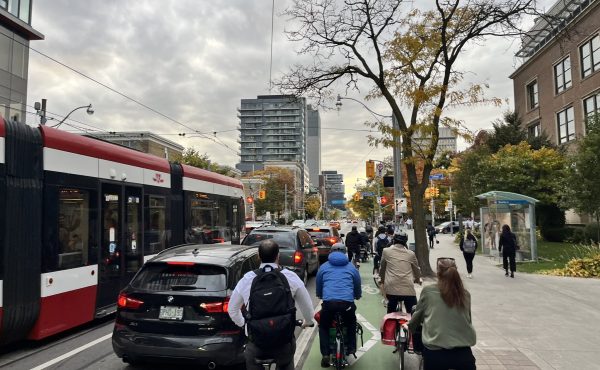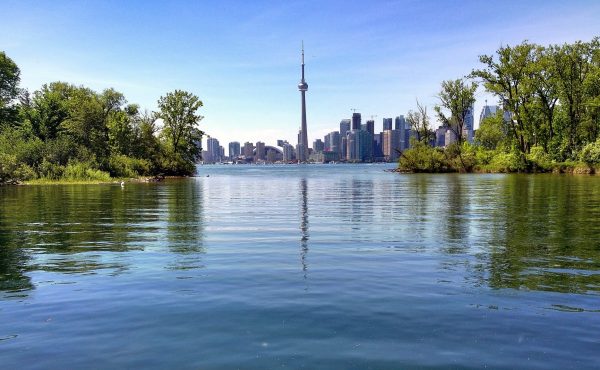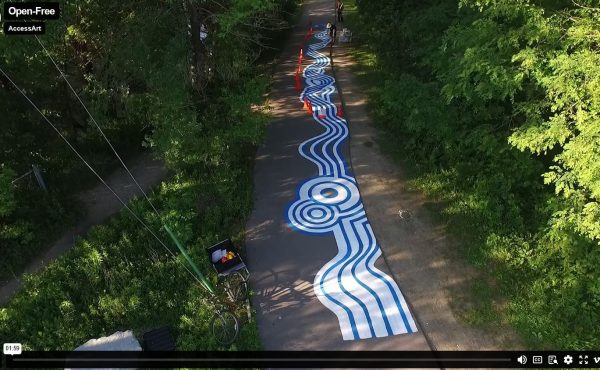The 100 most dangerous intersections for pedestrians in Toronto. The larger the dot, the greater the danger.
Yesterday, Global News released a map by mapmaker-journalist Patrick Cain of the 100 most dangerous intersections for pedestrians in Toronto relative to the volume of pedestrians at the intersection. This map is a big step forward from past efforts to identify the most dangerous intersections for pedestrians, because it takes into account the number of pedestrians who use each intersection, showing the proportional risk of each one. (Disclosure: I was interviewed in advance for this Global News feature)
What stands out is that, although there are more pedestrians in the centre of the city, most of the dangerous intersections are in the suburbs. The message is particularly striking if you compare a map of the volume of pedestrians who use all Toronto signalized intersections that have more than 500 pedestrians a day, with a map of the proportion of those pedestrians who are injured in collisions at these intersections. The maps are virtually the inverse of each other.
Here’s the map of the volume of pedestrians at signalized intersections in Toronto (deeper red = more pedestrians use the intersection):
And here is the map of the likelihood that a pedestrian using one of these intersections will be injured in a collision with a vehicle (deeper red = more likely a pedestrian will be injured):
There is, literally, safety in numbers. The more pedestrians use an intersection, the more likely it is that each pedestrian will be safe.
The other lesson is about infrastructure. Most of the most dangerous intersections are along suburban arterials — wide roads (meaning they take longer to cross) with fast speeds (meaning a car is more likely to cause injury).
When we dig a little deeper, we find some interesting results. For one thing, a surprising number of the worst intersections are at the intersection between an arterial road and a local road (including the worst, Markham Road and Tuxedo Court) rather than at major intersections. At major intersections, drivers may be at least expecting pedestrians, whereas at minor ones they may be much more focused on other cars. Another possible issue is the length of the signal cycle — where a minor road meets a major one, pedestrians wanting to cross the major road will have to wait a long time for the light to change, and perhaps they are tempted to cross if they think they see a gap in traffic before the light turns green for them (especially if, for example, they are trying to catch a bus coming on the other side), thus putting themselves at risk.
Two of the top three worst intersections (#3 is Milliken Blvd. and Finch Ave. E.) are T-junctions where a minor road hits a major one, as are a disproportionate number of the other bad ones. The explanation for this is easy — every car coming out of the minor road on a green light is turning, right or left, at the same time as pedestrians cross the wide major street. It’s a recipe for conflict. And indeed the worst cause of pedestrian injuries in 2009 and last year (PDFs) was vehicles turning left into pedestrians who were crossing with the right-of-way, while vehicles turning right were also a serious cause of injuries.
If we look at those of the worst intersections that are in the central part of the city, several are at locations where traffic has come off a highway (Bloor and Castle Frank, Gerrard and River, Eastern and Leslie). Perhaps some drivers have a tendency to still be in highway mode, driving a little faster and still focused only on other cars. Bloor and Castle Frank is also a T-intersection, as is Harbord and Ossington. Others are well-known awkward configurations, such as Dundas and Roncesvalles. It’s interesting, however, that this one is the only overlap between BlogTO’s recent, more impressionistic, list of the 5 worst intersections (for everybody, not just pedestrians) and the Global list. The ones listed by BlogTO are indeed terribly designed, but maybe drivers and pedestrians are more careful because they are so obviously bad.
Curiously, however, often intersections near these self-evidently bad interections show up among the worst. The horrible intersection of Dupont/Annette/Dundas is not in the worst 100 — but Annette and Keele, just a few blocks west, ranks fairly high on that list. The six-points intersection of Bloor/Dundas/Kipling doesn’t show up, but the intersection of Dundas and Mabelle, just a few blocks away, does. And while Eglinton and Allen Road is not actually that bad in terms of injuries, Eglinton W. is very dangerous just a few blocks west where it meets Oakwood and then Glenholme.
The importance of putting the raw number of pedestrian injuries in the context of pedestrian volume becomes clear when comparing the list Toronto Police gave to BlogTO of the 10 intersections with the most pedestrian injuries (bottom of the post), and Global’s list of the 100 intersections with the most injuries relative to the volume of pedestrians using them. The downtown intersections in the police list disappear right off the top 100 — Dundas and Spadina, for example, is in fact one of the safer intersections in the city relative to the massive number of pedestrians who use it. Several of the suburban ones also disappear right off the top 100. Those that remain, such as Birchmount Rd and Sheppard Ave East, drop way down the list.
These statistics should have been correlated a long time ago, but for a long time parts of the City bureaucracy made it difficult to get hold of the statistics for pedestrian volumes across the city. It’s another example of the importance and usefulness of Freedom of Information requests and the media.
Now that the information is out there for everyone to see, maybe it will help mobilize local communities to push the City to find ways to make these intersections safer. Glenn De Baeremaeker, whose ward includes the #1 most dangerous intersection, is already calling for improvements.
And everyone can have a look at the map of all intersections to see how dangerous or safe their local intersections are.







14 comments
My feeling about the Keele & Annette intersection is that the problems come because the streets meet on such a weird angle. It’s way wider than it looks like it should be based on the width of the roads at that point, so it can take much longer to cross than you might expect which leads to pedestrians ignoring the flashing hand and still starting to cross and then not making it. It’s also got such strange turning angles that it might be difficult for cars to correctly judge when crossing pedestrians are far enough out of their travel path that they can safely turn around them.
Great job! However, I’ve used that nasty intersection at Eglinton and Leslie quite a bit, and never felt nearly as threatened as I do every day riding a bicycle in the downtown core. So, let’s see the data for cycling, please.
So for these T-intersections of a minor street into a major street that seem to be the most dangerous (or for the other ones), would it help to give pedestrians a “walk” signal while the traffic lights remain red in every direction, Dylan? I’m not a traffic planner nor safety engineer, so this may introduce other problems…
I am going to guess that most of the injuries at castle frank aren’t happening at the bloor/castle frank intersection but at the intersection slightly north of there…it’s a terribly designed intersection – with sidewalks ending in the middle of no-where leading to pedestrians trying to basically cross an off-ramp (and add in the blind turn coming up a hill)…add to this, people driving out of castle frank rd. onto the on-ramp across two lanes to make a left onto danforth…as well as people coming north across the ramp onto castle-frank or the other road…they should add rumble strips coming around the corner to slow people down, and make the intersection north of the lights either signalized or a four way stop…get rid of the useless sidewalks (or make a signalized crossing, with advanced warning lights further down the hill)…it’s terrible…I’ve personally seen 3 accidents in the three years I’ve been there (all car related, no pedestrians)…
I would love the raw pedestrian volume counts. As part of my undergrad degree, I wrote a paper on pedestrian fatalities in Toronto, but used much less precise commuter travel mode data from the Census to estimate pedestrian volume. It showed a similar pattern, but also really highlighted Bathurst St as dangerous.
It would be really interesting to look at how these pedestrian volume & injury locations relate to automobile traffic volume, and resident age too.
Why isn’t this data available to everyone at http://toronto.ca/open ?
John – if you go to the pedestrian volume map, you can click on individual intersections (it’s a bit finicky because the squares are small) to get the pedestrian count. I’m going to post more info about the pedestrian volumes tomorrow.
Completely agree re. Open Toronto – it seems like an obvious thing to make available. Yet another case of the City of Toronto having great intentions and weak follow-through.
Nick – yes, I think that an advanced pedestrian walk signal at T-intersections could well help. That’s a great idea. I’ll try to suggest it to City staff.
Hi, K. –
The problem with mapping cycling accidents in the same way is the lack of traffic counts in most cases – I realize the cordon count intersections are an exception. The pedestrian maps are possible b/c of the enormous amount of information the City has about pedestrian volumes, down to the most obscure intersections.
Hi John,
This data was acquired through a Freedom of Information request. We’ll be making it publicly available on Globalnews.ca in the coming days in a downloadable format. I’ll post the link here.
One thing that would significantly reduce pedestrian injuries and fatalities is to ban right-hand turns on red lights. Everyday after work, I walk down Kennedy Rd from just north of the 401 to Ellesmere station, and it is a rare day when I don’t have to stop in my tracks in order to avoid being hit by a right-turning vehicle at the 401 off-ramp or at Progress Ave. The problem is simple: drivers approaching a red light at an intersection where they intend to turn right are looking to their left for oncoming traffic. If there happens to be a gap, they’ll proceed right through without coming to a full stop, and without even looking to their right for any pedestrians who may be about to cross on a green light. If I asserted my right-of-way as a pedestrian on green lights I’d be dead many times over by now. This is ridiculous and must end. Let’s ban right-hand turns on red lights within city limits.
The daily average numbers seem really low. As somebody who has handed out flyers at the corner next to a school and the subway, you can have 600 people in an hour so how do they get a 611 daily average?
We’ve open-sourced the original files:
http://bit.ly/lbYBo6
As promised, you can download the data set here: http://www.globalnews.ca/Globalnews+makes+pedestrian+safety+data+available+public/4913319/story.html
The data used for the pedestrian maps is now available here:
http://www.globalnews.ca/Globalnews+makes+pedestrian+safety+data+available+public/4913319/story.html